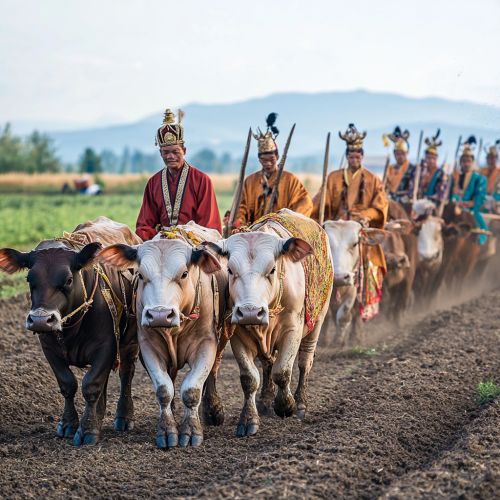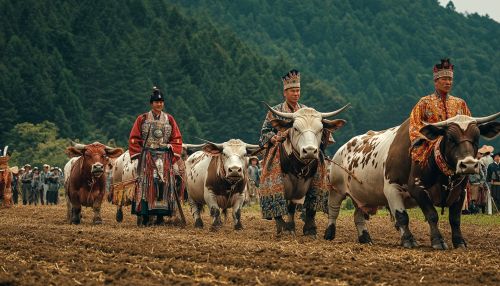Royal Ploughing Ceremony
Introduction
The Royal Ploughing Ceremony, known in various Southeast Asian cultures, is an ancient agrarian rite marking the beginning of the rice-growing season. This ceremonial event is deeply rooted in the agricultural traditions of countries like Thailand, Cambodia, and Myanmar. It symbolizes the importance of agriculture in these societies and serves as a ritual to invoke blessings for a bountiful harvest. The ceremony is a blend of Buddhist and Hindu traditions, reflecting the historical and cultural syncretism in the region.
Historical Background
The origins of the Royal Ploughing Ceremony can be traced back to ancient India, where it was known as the Ashvamedha or Vajapeya, rituals associated with kingship and fertility. As Indian culture spread to Southeast Asia, these rituals were adapted to local contexts. The ceremony has been practiced for over a millennium, with historical records indicating its performance in the Khmer Empire and the Ayutthaya Kingdom.
In Thailand, the ceremony is known as "Raek Na Khwan" and has been an integral part of the royal calendar since the Sukhothai period. In Cambodia, the ceremony is called "Preah Reach Pithi Chrot Preah Neangkol" and is similarly significant. The ceremony underscores the monarch's role as a protector and provider for the people, ensuring agricultural prosperity.
Ceremony Details
Preparations
The preparations for the Royal Ploughing Ceremony are meticulous and involve various stakeholders, including government officials, religious leaders, and farmers. The date is chosen based on astrological calculations, ensuring alignment with auspicious times. The site is typically a large open field, often near a royal palace or a significant temple.
Ritual Components
The ceremony consists of several key components:
- **Procession:** The event begins with a grand procession, featuring the king or a high-ranking official, often referred to as the "Lord of the Plough." Accompanied by Brahmin priests, the procession includes sacred animals, such as oxen, adorned with ceremonial garb.
- **Ploughing:** The central act involves the symbolic ploughing of the field. The Lord of the Plough guides the oxen to till the soil, marking the start of the planting season. This act is believed to bless the land and ensure fertility.
- **Seed Sowing:** After ploughing, seeds are sown into the freshly tilled earth. These seeds, often a mix of rice and other grains, are blessed by priests and distributed to farmers after the ceremony.
- **Prediction Rituals:** The ceremony includes divination practices to predict the coming season's agricultural success. Priests interpret the behavior of the oxen and the selection of food items they prefer, which are laid out on trays. The choices made by the oxen are believed to forecast weather patterns and crop yields.
Cultural Significance
The Royal Ploughing Ceremony is not merely an agricultural event but a cultural spectacle that reinforces national identity and unity. It is a public holiday in many countries, drawing large crowds and media attention. The ceremony is a reminder of the agrarian roots of Southeast Asian societies and the continuing importance of agriculture in their economies.


Symbolism and Interpretation
The Royal Ploughing Ceremony is rich in symbolism, reflecting the interconnectedness of nature, spirituality, and governance. The ploughing act symbolizes the monarch's duty to nurture and protect the land. The ceremony also represents the cyclical nature of life and the dependence of human societies on natural rhythms.
The involvement of sacred animals and priests highlights the spiritual dimensions of agriculture, where farming is seen as a divine activity requiring cosmic harmony. The ceremony's predictions serve as a form of traditional meteorology, providing guidance to farmers.
Modern Adaptations
In contemporary times, the Royal Ploughing Ceremony has evolved to incorporate modern elements while retaining its traditional core. In Thailand, for instance, the ceremony is presided over by a member of the royal family or a high-ranking official, symbolizing the monarchy's continued relevance.
The event is also an opportunity for governments to promote agricultural policies and innovations. Exhibitions showcasing modern farming techniques and equipment are often held alongside the ceremony, bridging the gap between tradition and modernity.
Regional Variations
While the core elements of the Royal Ploughing Ceremony are consistent across regions, there are notable variations:
- **Thailand:** The ceremony is held in Sanam Luang, Bangkok, and is a major state event. It is broadcast nationwide, emphasizing its national significance.
- **Cambodia:** The ceremony takes place in front of the National Museum in Phnom Penh. It is presided over by the King or a royal representative, with a strong emphasis on Buddhist rituals.
- **Myanmar:** Known as "Lehtun Mingala," the ceremony is less formalized but retains its cultural importance, with local variations in the rituals performed.
Challenges and Criticisms
Despite its cultural importance, the Royal Ploughing Ceremony faces challenges in the modern era. Critics argue that the event is largely symbolic and does not address the practical needs of contemporary agriculture. Issues such as climate change, technological advancements, and economic pressures require more than traditional rituals.
However, proponents argue that the ceremony serves as a cultural anchor, preserving heritage and fostering national pride. It also provides a platform for discussing agricultural issues and promoting sustainable practices.
Conclusion
The Royal Ploughing Ceremony is a testament to the enduring significance of agriculture in Southeast Asian cultures. It is a complex ritual that blends spirituality, tradition, and modernity, reflecting the dynamic nature of these societies. As the region continues to evolve, the ceremony remains a vital link to the past, offering insights into the cultural and historical landscapes of Thailand, Cambodia, and Myanmar.
